
Concept explainers
(a)
Interpretation:
The complete, detailed mechanism and products for the given reaction are to be drawn assuming that it takes place via an
Concept introduction:
Answer to Problem 8.13P
The complete, detailed mechanism for the given reaction, assuming that it takes place via an
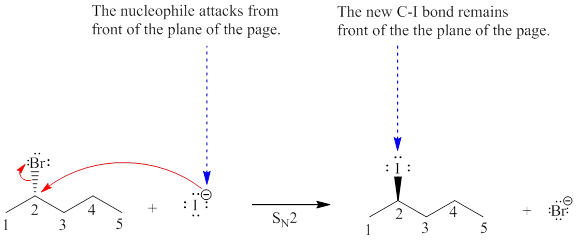
Explanation of Solution
The given reaction is:

The reactant molecule contains one chiral center at the C2 carbon atom. The leaving group is

In given alkyl halide C2 carbon atom is chiral in nature and affected throughout the course of the reaction. The nucleophile
For the given
(b)
Interpretation:
The complete, detailed mechanism and products for the given reaction are to be drawn assuming that it takes place via an
Concept introduction:
Answer to Problem 8.13P
The complete, detailed mechanism for the given reaction, assuming that it takes place via an
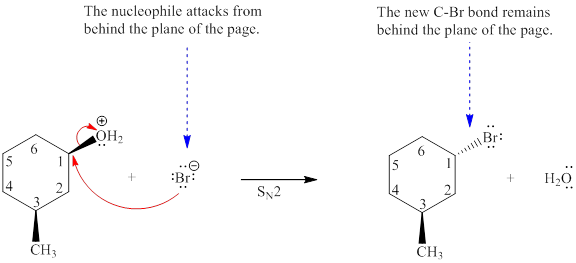
Explanation of Solution
The given reaction is
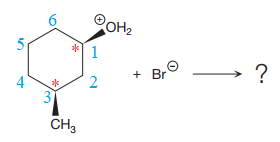
The reactant molecule contains two chiral centers at C1 and C3 carbon atoms. The leaving group is

Note that the stereochemical configuration at the chiral center at C3 remains unchanged because no bonds to it were broken or formed. However, the stereochemical configuration at the chiral center at C1 changes as bonds to it are affected throughout the course of reaction. This will change the stereochemical configuration at C3 chiral carbon atom. Thus, a single stereoisomer will be generated.
For the given
(c)
Interpretation:
The complete, detailed mechanism and products for the given reaction are to be drawn assuming that it takes place via an
Concept introduction:
Answer to Problem 8.13P
The complete, detailed mechanism for the given reaction, assuming that it takes place via an
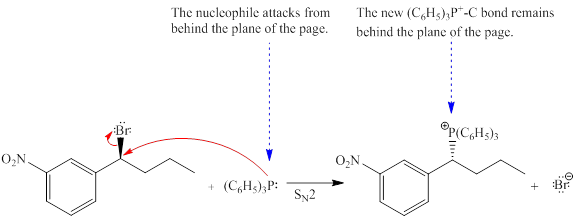
Explanation of Solution
The given reaction is
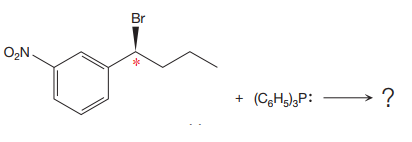
The reactant molecule contains one chiral center. The leaving group is

Note that, the stereochemical configuration at the chiral center changes as bonds to it ae affected throughout the course of reaction. This will change the stereochemical configuration at the chiral center, and it will be opposite than the reactant molecule. Thus, a single stereoisomer will be generated.
For the given
Want to see more full solutions like this?
Chapter 8 Solutions
EBK ORGANIC CHEMISTRY: PRINCIPLES AND M
- Draw a tetramer of this alternating copolymer.arrow_forwardH I T H HH H -H C. H- Identify and select all structures below that represent a constitutional isomer(s) of the compound shown above. H- H CIH H H H HHHH H H 0 ·H H– 冊 CH CHI HH C- H- H H- H H A. H H C H H- -H HH H B. H- -H D. H H H H • H -H E. -H H H HICH T HHH F. H-arrow_forwardPolylactic acid (shown below) is a biodegradable polymer used for food packaging. Identify the monomer(s) used in the production of this polymer using a condensation process.arrow_forward
- Draw the product of the reaction shown below. Ignore small byproducts that would evaporate pleasearrow_forwardPoly(ethylene adipate) is a biodegradable polyester (shown below). Identify the type of polymerization process used in the production of this polymer.arrow_forwardPolymers may be composed of thousands of monomers. draw two repeat units(dimer) of the polymer formed in this reaction. assume there are hydrogen atoms on the two ends of the dimer. ignore inorganic byproducts pleasearrow_forward
- Draw the product of the reaction shown below. Use a dash or wedge bond to indicate stereochemistry of substituents on asymmetric centers, Ignore inorganic byproductsarrow_forwardDraw the product of this reaction please. Ignore inorganic byproductsarrow_forwardOne of the pi molecular orbitals of 1,3-butadiene (CH2=CHCH=CH2) is shown below. Please identify the number of nodal planes perpendicular to the bonding axisarrow_forward
- Draw the monomers required to synthesize this condensation polymer please.arrow_forwardProvide the correct systematic name for the compound shown here. Please take into account the keyboard options belowarrow_forwardcurved arrows are used to illustrate the flow of electrons. using the provided starting and product structures, draw the curved electron-pushing arrows for the following reaction or mechanistic step(s)arrow_forward
 Organic Chemistry: A Guided InquiryChemistryISBN:9780618974122Author:Andrei StraumanisPublisher:Cengage Learning
Organic Chemistry: A Guided InquiryChemistryISBN:9780618974122Author:Andrei StraumanisPublisher:Cengage Learning
